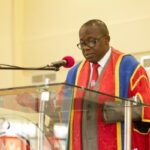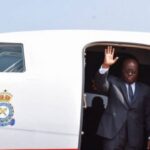Founding President and Chief Executive Officer (CEO) of IMANI Africa, Franklin Cudjoe has observed that plans by the government to revamp Ghana’s railway sector are “positively ambitious” but costly.
He said, government’s ambition to construct two separate rail lines from the south to the north ending at Tamale through to the eastern part of the country and from Kumasi to Tamale would be the most significant rail development since Ghana’s independence.
Though this is a laudable project, Franklin Cudjoe raises major concerns with the cost involved in the construction of new rail lines.
“The new rail line currently being constructed through relatively easy topography between Tema and Mpakadan (a distance of 97 Kms) is costing approximately $0.5 to build and provide new rolling stock. This section of the plans will have distinct advantages. However, to build a new railway line from Mpakadan to Yapei (420 Kms) where rights of way have to be secured and difficult topographical challenges exist, will cost a minimum of $2.2 bn, and building a new rail line from Kumasi to Yapei, a distance of 300 Kms, even if a straight line route is selected (unlikely), will cost $1.5 bn,” he stated in an article.
The IMANI President did not only identify issues with the project but also suggested a “better idea” to the government and Ministry of Railways and Development.
Read the article below
IMANI Alert: Government’s Railway Development Plans Are Positively Ambitious but Costly- Here is a Better Idea
Introduction:
It’s exciting to hear of bold new plans to revitalise and expand infrastructure in Ghana especially when it’s proposed on a scale that appears to demonstrate courage and vision. Ghana’s president in his 2019 SONA, and Ministry of Rail Development have announced plans to construct two separate rail lines from the south to the north ending at Tamale, and then onwards as the primary northerly route to Bolgatanga and Ouagadougou. One of the two lines is planned for the eastern side of Ghana between Tema and Tamale via Hohoe and Yendi, the second is from Kumasi to Tamale. This remarkable plan would be the most significant rail development since Ghanas’ independence.
BACKGROUND:
- Rail transport is obviously a fixed route between any two destinations which also serves locations en route and alongside the rail line. Between those destinations it serves as a key mode of transport and facilitates growth in commerce and industry. However, destinations not on, or alongside/near, the line must be connected by other means of transport as feeder services – whether for passengers or freight.
- It is regrettable that very few rail lines worldwide are self-funded by passenger traffic alone and there are none in Africa. Yet the rationale and business case – both economically and commercially – for upgrading and refurbishing Ghana’s existing rail lines in the south, as currently planned and beginning to be implemented,are indeed justified.
However, upon closer inspection the plans to build new rail line in the north overlook existing natural waterway infrastructure already in place, serviceable and requires only a fraction of the investment needed to deliver the northern rail proposals. Here’s how:
A Closer Look
- The new rail line currently being constructed through relatively easy topography between Tema and Mpakadan (a distance of 97 Kms) is costing approximately $0.5 to build and provide new rolling stock. This section of the plans will have distinct advantages.
- However, to build a new railway line from Mpakadan to Yapei (420 Kms) where rights of way have to be secured and difficult topographical challenges exist, will cost a minimum of $2.2 bn, and building a new rail line from Kumasi to Yapei, a distance of 300 Kms, even if a straight line route is selected (unlikely), will cost $1.5 bn.
- These two new lines as far as Tamale will sandwich the Volta Lake, a logistical duplication costing $3.7bn! The Volta Lake is an existing natural transport corridor created by the vision of forebears, but still awaiting proper development. This ‘watery highway’ does not need to be designed, planned, constructed, nor maintained or repaired. It can be used to carry cargoes at one half the operating cost of an existing rail line and a fraction of the cost of new rail lines.
- To build either one of the two proposed newlines to northern Ghana will unfortunately mirror the already existing, and operationally much cheaper inland waterway. The duplication of the transport corridor represented by the Volta Lake by creating new rail lines is not justified by any argument.
- Moreover, upgrading the total transport capacity of Volta Lake as an inland transport corridor is a financially more attractive option. Renovations to existing transport terminae as well as the construction of brand new facilities at strategically advantageous locations around the shoreline, while fully meeting social obligations, corporate social responsibilities, widespread lakeshore community development, not to mention impressive ‘green credentials’, will cost $0.5 billion – and is commercially and environmentally sustainable. It’s the complete package at a fraction of the cost.
- Any investor, even for government projects such as rail lines and inland waterways, expects at least a 10% return from the investment simply to cover finance charges and, over a longer term, to recover the capital costs alone.
- The known cargoes alone, i.e. not passengers (confirmed by others and accurately assessed by several sources) to northern Ghana and the land locked countries further north are currently approximately 3,000,000 tonnes of cargo per annum. At an average cost of $0.064 (6.4 US cents) per tonne/kilometre by road (Burkina Shippers Council advice and actual current quotes) the income for freight carriage to Bolgatanga by road is $192m per year. If any future rail service is even slightly more expensive then the cargoes will continue to go by road.
- The cost to construct and equip a single track rail line from the Gulf of Guinea (Takoradi or Tema) to Bolgatanga (a distance by rail of approx 800 Kms) is a minimum of $4 billion (NB: this does not include Ghana taxpayer costs of wayleaves, encroachment removal, line fencing, design, clients engineers, transaction advisors etc which may alone add a further $1 billion to the cost). Thus this investment requires a minimum of $400,000,000. – income from transport services per annum.
- Advocating the cost effective use and multi-community development through Inland Water Transport (IWT)
- Regardless of the absence of a commercial justification for the new rail line (one line, not the two separate routes being proposed) if the Ghana taxpayer can afford the almost double rail freight cost subsidy to justify the economic growth potential of new rail lines across remote and sparsely populated areas – then so be it.
If the rationale of the previous paragraph is justified it still does not explain why government is insisting on building a rail line from Kumasi to Tamale when – for cargoes from the Tema to Tamale – an inland waterway already exists and will cost a fraction of the equivalent rail build to create. And the development of the inland waterway will immediately benefit a much wider section of the population including the large already deprived and displaced communities (estimated to be two million people).
It should be noted, however, that only in the development of the USA were railways used to grow a nation in the history of mankind. It has never before been done elsewhere in the world, not to mention Africa. With the exception of South Africa (due to its’ large coal transport needs) every historical rail system in Africa has failed – and any rare current new lines – are either dedicated freight lines for large ore deposits or have no commercial justification now, nor expected for generations to come. The success of rail transport had its heyday almost a century ago. Since then individuals globally have been more often seduced by four wheeled vehicles than all other forms of wheeled transport; “non-wheeled” water transport remains a significant alternative as it complements car journeys, not competes with them.
Inland water transport (IWT) across Ghana is commercially attractive and sustainable at 20% lower cost than road transport yet the concept languishes in the blind spot of infrastructure planners. If a project can’t be shown to make commercial sense and give Ghana a new route to growth and prosperity, then it begs the question who actually would benefit from building those railways that go where the Lake already goes? There is no need due to having a much simpler and cheaper transport option.
The Volta Lake stands already as a gleaming testimony to the engineering mastery of a former generation. It is a gift that modern Ghana has inherited and which the present incumbents are privileged to have as a resource to easily, and quickly, grow the nations’ wealth and productivity. The potential to use IWT for low cost development and also for national pride cannot be overstated. It will set Ghana apart among all African nations.
The above are the perspectives of Martin Hiles, a West African Logistician with decades of experience in transportation and an IMANI Associate.
Respectfully yours,
Franklin Cudjoe
Founding President & CEO, IMANI
Bio:http://www.franklincudjoe.org/home/
Office:https://goo.gl/maps/YafE18tq88N2
Twitter: @lordcudjoe
Cell:+233 244 638 178
Cell: +233 263 983 084
By: Kekeli Kuatsenu/awakenewsonline.com








